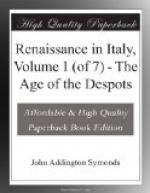of the Transteverine part of the city moves even deeper
scorn. ’It still remained for the Imperial
troops to enter the populous and wealthy quarters;
and these they had to reach by one of three bridges.
They numbered hardly more than 25,000 men, all told.
In Rome were at least 30,000 men fit to bear arms
between the ages of sixteen and fifty, and among them
were many trained soldiers, besides crowds of Romans,
swaggering braggarts used to daily quarrels, with beards
upon their breasts. Nevertheless, it was found
impossible to get 500 together in one band for the
defense of one of the three bridges.’ What
immediately follows gives so striking a picture of
the sack: that a translation of it will form
a fit conclusion to this volume. ’The soldiers
slew at pleasure; pillaged the houses of the middle
classes and small folk, the palaces of the nobles,
the convents of both sexes, and the churches.
They made prisoners of men, women, and even of little
children, without regard to age, or vows, or any other
claim on pity. The slaughter was not great, for
men rarely kill those who offer no resistance:
but the booty was incalculable, in coin, jewels, gold
and silver plate, clothes, tapestries, furniture,
and goods of all descriptions. To this should
be added the ransoms, which amounted to a sum that,
if set down, would win no credence. Let any one
consider through how many years the money of all Christendom
had been flowing into Rome, and staying there in a
great measure; let him remember the Cardinals, Bishops,
Prelates, and public officers, the wealthy merchants,
both Roman and foreign, selling at high prices, letting
their houses at dear rents, and paying nothing in
the way of taxes; let him call to mind the artisans,
the poorer folk, the prostitutes; and he will judge
that never was a city sacked of which the memory remains,
whence greater store of treasure could be drawn.
Though Rome has at other times been taken and pillaged,
yet never before was it the Rome of our days.
Moreover, the sack lasted so long that what might
not perhaps have been discovered on the first day
sooner or later came to light. This disaster was
an example to the world that men proud, avaricious,
envious, murderous, lustful, hypocritical, cannot
long preserve their state. Nor can it be denied
that the inhabitants of Rome, especially the Romans,
were stained with all these vices, and with many greater.’
[1] Pp. 372-82.
INDEX
A
Abelard, 9.
Adrian VI., 441.
Agrippa quoted, 459.
Ahmed, 589.
Albigenses, 9.
Aldi, the, 23.
Aleander, 27.
Alexander VI., 406, 407 seq.., 603;
death, 430 (see Papacy).
Alfonso I. of Naples, 568.
Alfonso II., 119, 572.
Allegre, 418,
Allegretti, works, 292;
cited, 165;
quoted, 616
America, effects of its discovery, 540.
Ammanati, works, 489.
Anjou, house of, transfers its claims to Sicily, 539.




